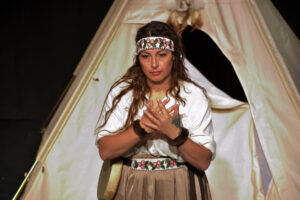On the night of Friday, July 25, I went to Langham Court Theatre to see Gold and The Boy in the Treehouse. I’ve been writing for Nexus for about eight years; during this time, I’ve reviewed dozens of plays. Every time I see a production, whether it’s widely recognized or brand new and just hatched from the egg, my scope of the world and the people in it widens just a little more.
However, I’ve never seen two theatre pieces in one evening, and I was gritting my teeth a little at the idea of doing so. But when Gold took the stage, I was pulled in immediately. I have no idea where the time went. It blew me away.

Gold, presented by Victoria’s Indigenous Healing Arts Network, is an interpretive theatrical production performed through contemporary dance. Written by Katłı̨̀ą and directed by Diana Budiachenko, the piece is a pantomime, a haunting rendition of the story of the infamous Giant Mine in Yellowknife, Northwest Territories. The Giant Mine is on Dënéndeh lands of the Dene; “Dene” means “flowing from earth,” and in the Dene language, “Dënéndeh” means “land of the people.”
I was not educated about the history of the Giant Mine, so I knew I needed to read up on some information in order to understand and feel some of the nightmare that went on for almost a century.
Giant Mine was established in the 1940s and is an ominous reminder of Canada’s gold rush history. From 1948 to 2004 it produced roughly seven million ounces of gold; however, 237,000 tonnes of arsenic trioxide lurked through its chamber. Throughout the years, that arsenic, a by-product of the gold-making process, poisoned the land and water, provoking illness among the Dene community, including the death of a child in 1951.
This tragic true story is written into the dance of Gold; the choreography is a powerful, painful, and sincere articulation. I was drawn in to the dance as if I was right there in the minds of the people on stage—I was a part of their story. There are only three dancers, but they are constantly changing. They took form as greedy miners who are trying desperately to make their fortune, a newlywed family, scientists… and the list goes on.
The themes in the story are large for the piece’s runtime (roughly half an hour) but the actors/dancers pull it off beautifully. The character of the Indigenous woman who is forced from her home just flattened me. She holds so much power in her movements, and her eyes told a story all by themselves. Gold is intense, educational, and full of talent.
The Boy in the Treehouse was a good place to pick up after the intermission. Because I was so amped after Gold, I appreciated the chance to mellow out a bit.
Produced by Nanaimo’s Reconciliation Theatre, The Boy in the Treehouse has been on a bit of a journey, touring various cities before ending up in Victoria.
Written by Drew Hayden Taylor and directed by Pete Kytwayhat, the piece tells the story of Simon, a pre-teen boy who is going through hard and painful questions about identity. He has different challenges than other kids his age: he’s grieving the loss of his mother, his only Anishinaabe parent. Simon uses his treehouse to seek refuge; it’s a place for him to think and be on his own, and to honour his mother through practicing some of the Anishinaabe traditions that he fears may be forgotten while now being raised only by his white father.
Although it was clearly an amateur performance, I admired the enthusiasm that the whole cast conveyed, and I believe that as they continue touring, the production will become stronger every time. The Boy in the Treehouse hits on important points, mainly how white people are dismissive of Indigenous cultural practices, often because they don’t understand. The message has stayed with me.
